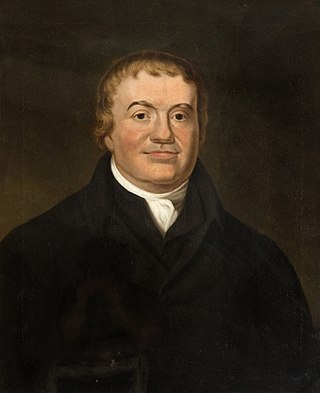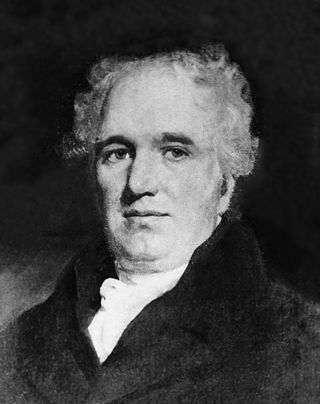Related Research Articles

Ghanshyam Das Birla was an Indian businessman and member of the Birla Family.

Catrine is a village in East Ayrshire, Scotland which was formerly a centre of cotton manufacture. It has a population of around 2,020 (mid-2020 est.)

David Dale was a leading Scottish industrialist, merchant and philanthropist during the Scottish Enlightenment period at the end of the 18th century. He was a successful entrepreneur in a number of areas, most notably in the cotton-spinning industry, and was the founder of the cotton mills in New Lanark, where he provided social and educational conditions far in advance of anything available anywhere else in the UK. New Lanark attracted visitors from all over the world. Robert Owen, who married Dale’s daughter, Caroline, in 1799, used New Lanark to develop his theories about communitarian living, education and character formation. Scottish historian, Tom Devine, described Dale as ‘the greatest cotton magnate of his time in Scotland’.
Champdani is a city and a municipality of Hooghly district in the Indian state of West Bengal. It is under Bhadreswar police station in Chandannagore subdivision. It is a part of the area covered by Kolkata Metropolitan Development Authority (KMDA). This town is famous for six factories, viz.the GIS Cotton Mill, Dalhousie Jute Mill, North Brook jute Mill, Angus jute Mill, Champdany Garbage Refinary Ltd, Lagan Engineering, and Braithwate Ltd.
Dundee is the fourth-largest city in Scotland with a population of around 150,000 people. It is situated on the north bank of the Firth of Tay on the east coast of the Central Lowlands of Scotland. The Dundee area has been settled since the Mesolithic with evidence of Pictish habitation beginning in the Iron Age. During the Medieval Era the city became a prominent trading port and was the site of many battles. Throughout the Industrial Revolution, the local jute industry caused the city to grow rapidly. In this period, Dundee also gained prominence due to its marmalade industry and its journalism, giving Dundee its epithet as the city of "jute, jam and journalism".

Deanston is a village in the Stirling council area, Scotland, on the south bank of the River Teith east of Doune, in south-west Perthshire. It is a part of the parish of Kilmadock.

Kirkman Finlay was one of the leading merchants in Glasgow, Scotland. He was Lord Provost of Glasgow and Member of Parliament.
The five Ralli brothers, Zannis a.k.a. John (1785–1859), Augustus (1792–1878), Pandia a.k.a. Zeus (1793–1865), Toumazis (1799–1858), and Eustratios (1800–84), founded Ralli Brothers, perhaps the most successful expatriate Greek merchant business of the Victorian era.

Sir Allan Arthur (1857-1923) was a Scotland international rugby football player. He later moved to India as a merchant, where he became a civil servant. He was knighted in 1900 for his Indian public service work. He was named as one of Queen Victoria's birthday knights.
Sir John Valentine Jardine Paterson was a Scottish businessman whose career was mostly in India.

Jardine, Matheson & Co., later Jardine, Matheson & Co., Ltd., forerunner of today's Jardine Matheson Holdings, was a Far Eastern company founded in 1832 by Scotsmen William Jardine and James Matheson as senior partners. Trafficking opium in Asia, while also trading cotton, tea, silk and a variety of other goods, from its early beginnings in Canton, in 1844 the firm established its head office in the new British colony of Hong Kong then proceeded to expand all along the China Coast.
Scottish-Indians are Indian citizens of mixed Indian and Scots ancestry or people of Scottish descent born or living in India. Like Irish Indians, a Scottish-Indian can be categorized as an Anglo-Indian. Scottish Indians celebrate Scottish culture, with traditional Scottish celebrations like Burns Night widely observed among the community.
Jardine, Skinner and Company was a trading company based in Calcutta, India. It was founded in 1825, initially dealing in textiles. Later it branched out into opium, tea, timber and petroleum. The company was closely associated with Matheson & Company of London and Jardine Matheson & Co. of Hong Kong.
Matheson & Company was a London-based trading house closely associated with Jardine Matheson of Hong Kong and Jardine Skinner of Calcutta. It arranged finance and handled imports from those two companies of products such as tea, silk and jute. Matheson & Company also became involved in venture-capital, specializing in mining. The company was a member of the consortium that formed the Rio Tinto Company. After 1912 it became a subsidiary of Jardine Matheson.

In Scotland, the Industrial Revolution was the transition to new manufacturing processes and economic expansion between the mid-eighteenth century and the late nineteenth century. By the start of the eighteenth century, a political union between Scotland and England became politically and economically attractive, promising to open up the much larger markets of England, as well as those of the growing British Empire, resulting in the Treaty of Union of 1707. There was a conscious attempt among the gentry and nobility to improve agriculture in Scotland. New crops were introduced and enclosures began to displace the run rig system and free pasture. The economic benefits of union were very slow to appear, some progress was visible, such as the sales of linen and cattle to England, the cash flows from military service, and the tobacco trade that was dominated by Glasgow after 1740. Merchants who profited from the American trade began investing in leather, textiles, iron, coal, sugar, rope, sailcloth, glass-works, breweries, and soap-works, setting the foundations for the city's emergence as a leading industrial center after 1815.

Sir John Muir, 1st Baronet DL JP (1828–1903) was a Scottish businessman who served as Lord Provost of Glasgow from 1889 to 1892. He founded Finlay Muir & Co, one of the world's largest 19th century companies.

Walker Sons and Company was an engineering firm established in Kandy in 1854 by a Scottish engineer, John Walker, as John Walker and Co. It was the seventh oldest operating company in Sri Lanka. Today, the name operates as an investment holding company under the umbrella of the MTD Walkers group, but ceased operations in its original form in the 1980s

Alexander Dennistoun was a Scottish merchant, bank director, property developer and, for two years, from 1835 to 1837, a Member of Parliament for Dunbartonshire. He was responsible for establishing the Glasgow residential area Dennistoun, named after him.
The Wallace brothers were the six sons of Edinburgh architect Lewis Wallace. In varying combinations, the brothers established themselves as one of the leading nineteenth century East India merchants, trading in cotton, tea, coffee and other commodities. Through their investments in Burma, they became the world's leading exporter of teak. The rise of independent governments after World War II meant the progressive loss of the family's Eastern assets and the redeployment of capital back to London. This capital was used in the 1960s to establish Wallace Brothers as a banking house but this strategy did not long survive the secondary banking crisis of 1973-75.
References
- 1 2 3 4 5 6 Brogan, C., James Finlay & Company 1750-1950. Glasgow, 1951
- ↑ Scotsman 1 February 2017
- 1 2 T. M. Devine, "An Eighteenth-Century Business élite: Glasgow-West India Merchants, c. 1750-1815", The Scottish Historical Review; Vol. 57, No. 163, April 1978, Edinburgh University Press.
- 1 2 3 4 Glasgow Archive, Records of James Finlay
- ↑ "Wilson Kay". Glasgow Archive.
- ↑ "Sir John Muir of Deanston". Glasgow Museums.
- ↑ "Champdany Jute". Glasgow Archives.
- 1 2 "James Finlay Limited - Overview (free company information from Companies House)". beta.companieshouse.gov.uk.
- ↑ "Champdany Jute Co., Ltd Petitioners |[1923] SLR 209 | Scottish Court of Session | Judgment | Law | CaseMine". www.casemine.com.
- ↑ "James Finlay (Kenya) Limited". Companies House.
- ↑ "Records of James Finlay (Kenya) Limited". Glasgow Archives.
- ↑ Roger Jeffery,Merchant Capital and the End of Empire: James Finlay, Merchant Adventurers, Economic and Political Weekly Vol. 17, (Feb. 1982)